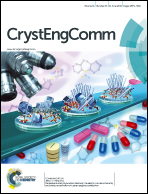Rigid yet flexible heteroleptic Co(iii) dipyrrin complexes for the construction of heterometallic 1- and 2-D coordination polymers†
Abstract
A series of four discrete complexes of the (acac)Co(dpm)2 or (hfac)Co(dpm)2 type incorporating either the 3- or 4-pyridyl appended dipyrrin (dpm) ligand has been prepared, characterized and employed as metallatectons for the construction of heterometallic coordination polymers (CPs) upon combination with CdX2 salts (X = Br, Cl). For these species, the Co(III) center, in an octahedral environment, is coordinated to two dpm chelates and to an acetylacetonate based capping ligand (acac or hfac). For both of the metallatectons and the infinite CPs, the rotation around the N–N chelate hinge is responsible for the different shapes adopted by the dpm moiety and hence different orientations of the peripheral pyridyl units. This behaviour does not seem to arise from the nature of the capping ligand (acac or hfac), the position of the peripheral pyridyl unit (3- or 4-) nor the nuclearity of the CdX2 nodes. Depending on the shape of the metallatecton and the orientation of the coordinating sites, 1D networks composed of metallamacrocyclic moieties and 2D grid type coordination polymers are obtained.


 Please wait while we load your content...
Please wait while we load your content...